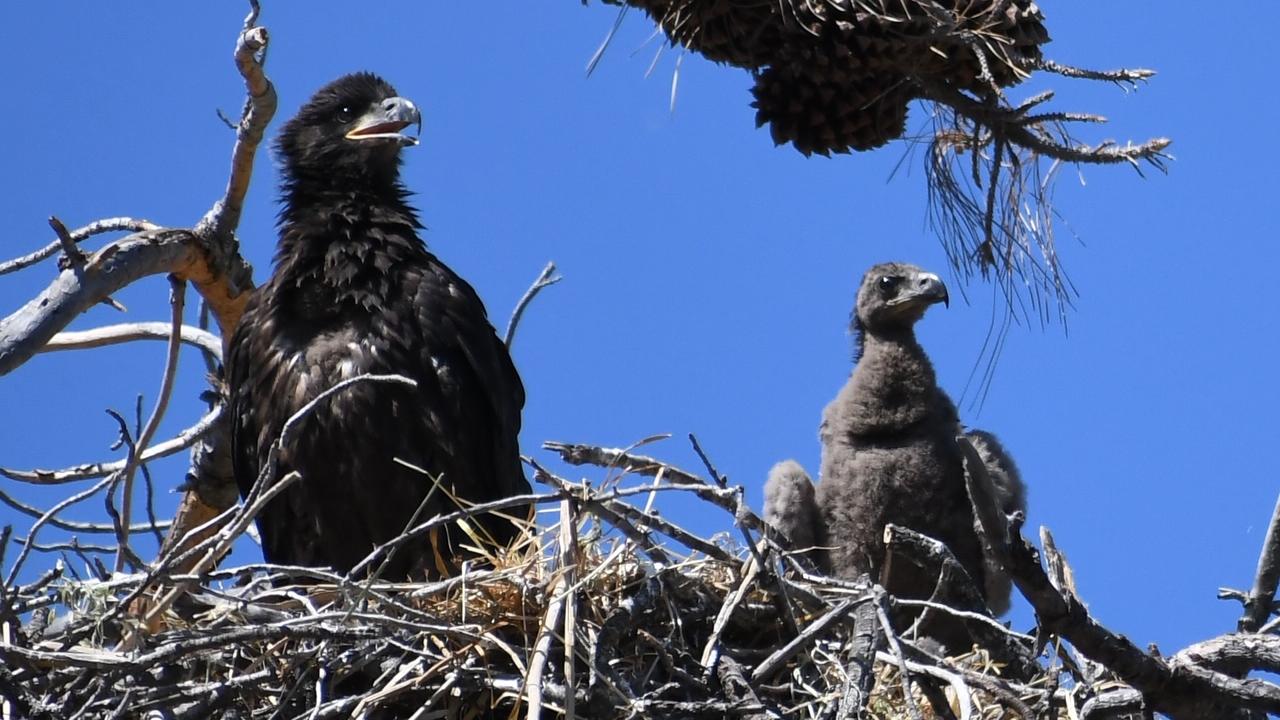
Surviving Against the Odds: The Story of the CRC's Newest Ambassador Eagle
Ingela Kaersvang thought the eaglet was dead.
The Rumsey resident was making one of her regular visits to a local Bald Eagle nest when she saw a gust of wind bring an eaglet crashing to the ground. The chick fell, hitting branches as he tumbled from the tree’s crown to the field below. "He hit the ground in a heap... and I was sure he was dead, and then he lifted his head," said Kaersvang.
The young Bald Eagle was the smaller of two siblings in the nest. Much smaller. Kaersvang’s pre-fall photos of the nest show the larger eaglet outpacing its sibling in both size and development. From the get-go, the littlest chick was at a disadvantage, but Kaersvang described watching him hold his own, get along with his sibling, and actively move around the nest.
His activity may have been what landed him in trouble that day he fell in late April. Kaersvang initially noticed one of the adult eagles acting more agitated than usual. Then she saw that the smaller eaglet had hopped down from or been knocked outside the nest cup, and he could not climb back into the safety of the inner nest. His parents called from above as he struggled to climb. It was a windy day; there was no way to help. Kaersvang could only watch.

(photo credit: Ingela Kaersvang)
After the chick fell, Kaersvang sprang into action, making her way to the base of the tree. When he raised his head and she realized he had survived his terrible fall, she knew he needed help. One of his wings hung limply by his side: he was clearly injured. She immediately phoned the California Raptor Center, then Yolo County Animal Services. Officer Breckenridge retrieved the eaglet and delivered him to the UC Davis Veterinary Medical Teaching Hospital, which partners with the CRC in treating birds of prey.

(photo credit: Ingela Kaersvang)
Specialists at the hospital’s Companion Exotic Animal Medicine and Surgery Service diagnosed fractures of the radius and ulna in both wings. Surgeons placed intramedullary (IM) pins in the eaglet’s wings to stabilize his fractures. Following surgery, the California Raptor Center took on the eaglet’s convalescence.
The California Raptor Center has years of experience rehabilitating adult and subadult Bald Eagles, but this chick was the youngest Bald Eagle patient in the center’s history. Never before had the CRC cared for a nestling Bald Eagle; few wildlife centers routinely receive such young eagles as patients. Adding to the challenges presented by this novel patient, the CRC was operating with barebones staff at the time due to the statewide lockdown.
Treatment included daily medications as well as physical therapy with use of ultrasound. The first few weeks of the eaglet’s recovery were touch-and-go: the young bird had a poor appetite and struggled to eat. Every day, CRC staff had to help him eat and support him with supplemental fluids. There was concern that if he could not turn the corner and begin to self-feed, then his odds of surviving were low.
Despite his slow initial progress, the eaglet, nicknamed “Peewee” by volunteers, gradually started to eat on his own. He graduated into a larger enclosure that allowed him to stretch and exercise his wings, which were improving with physical therapy. Brown juvenile feathers replaced his fluffy gray nestling down, and he began to look more like a full-sized eagle than a diminutive chick.
He regained significant range of motion in his wings thanks to physical therapy, but he showed little interest in flying, and his wings drooped slightly when held at his sides. Radiographs revealed areas of possible synostosis (fusion of the bones) in both wings, a consequence of his traumatic injuries. Veterinarians and staff also noticed that the small eaglet displayed species-atypical behaviors, and some of his new feathers grew in abnormally. This led to suspicions that the eaglet may have been developmentally compromised in the nest before he fell.

Right: the fractures in both of the eaglet's wings
After monitoring the eaglet over several weeks, staff concluded that the combination of his wing injuries and his abnormal behavior would render him incapable of surviving in the wild. They also recognized that his unusual demeanor—calm, with decreased reaction to stimuli that would perturb most other eagles—might predispose him to readily adjust to life as an educational ambassador bird. With that in mind, Volunteer and Outreach Coordinator Julie Cotton began daily training sessions with the eagle with the hope he might become the CRC’s first glove-trained Bald Eagle.

(photo credit: Billy Thein)
Two months later, “Peewee” has made tremendous progress. He now voluntarily steps onto the glove and will sit calmly on the glove for short walks inside his enclosure. He still has a long way to go before he will be ready to meet the public, but we hope that when the CRC is able to open to visitors again, he will be there to greet them.
“Peewee” will receive an official name soon. Stay tuned!

(photo credit: Billy Thein)

